Jiequan Cui
Project-Probe-Aggregate: Efficient Fine-Tuning for Group Robustness
Mar 12, 2025Abstract:While image-text foundation models have succeeded across diverse downstream tasks, they still face challenges in the presence of spurious correlations between the input and label. To address this issue, we propose a simple three-step approach,Project-Probe-Aggregate (PPA), that enables parameter-efficient fine-tuning for foundation models without relying on group annotations. Building upon the failure-based debiasing scheme, our method, PPA, improves its two key components: minority samples identification and the robust training algorithm. Specifically, we first train biased classifiers by projecting image features onto the nullspace of class proxies from text encoders. Next, we infer group labels using the biased classifier and probe group targets with prior correction. Finally, we aggregate group weights of each class to produce the debiased classifier. Our theoretical analysis shows that our PPA enhances minority group identification and is Bayes optimal for minimizing the balanced group error, mitigating spurious correlations. Extensive experimental results confirm the effectiveness of our PPA: it outperforms the state-of-the-art by an average worst-group accuracy while requiring less than 0.01% tunable parameters without training group labels.
Generalized Kullback-Leibler Divergence Loss
Mar 11, 2025Abstract:In this paper, we delve deeper into the Kullback-Leibler (KL) Divergence loss and mathematically prove that it is equivalent to the Decoupled Kullback-Leibler (DKL) Divergence loss that consists of (1) a weighted Mean Square Error (wMSE) loss and (2) a Cross-Entropy loss incorporating soft labels. Thanks to the decoupled structure of DKL loss, we have identified two areas for improvement. Firstly, we address the limitation of KL loss in scenarios like knowledge distillation by breaking its asymmetric optimization property along with a smoother weight function. This modification effectively alleviates convergence challenges in optimization, particularly for classes with high predicted scores in soft labels. Secondly, we introduce class-wise global information into KL/DKL to reduce bias arising from individual samples. With these two enhancements, we derive the Generalized Kullback-Leibler (GKL) Divergence loss and evaluate its effectiveness by conducting experiments on CIFAR-10/100, ImageNet, and vision-language datasets, focusing on adversarial training, and knowledge distillation tasks. Specifically, we achieve new state-of-the-art adversarial robustness on the public leaderboard -- RobustBench and competitive knowledge distillation performance across CIFAR/ImageNet models and CLIP models, demonstrating the substantial practical merits. Our code is available at https://github.com/jiequancui/DKL.
Pushing Rendering Boundaries: Hard Gaussian Splatting
Dec 06, 2024Abstract:3D Gaussian Splatting (3DGS) has demonstrated impressive Novel View Synthesis (NVS) results in a real-time rendering manner. During training, it relies heavily on the average magnitude of view-space positional gradients to grow Gaussians to reduce rendering loss. However, this average operation smooths the positional gradients from different viewpoints and rendering errors from different pixels, hindering the growth and optimization of many defective Gaussians. This leads to strong spurious artifacts in some areas. To address this problem, we propose Hard Gaussian Splatting, dubbed HGS, which considers multi-view significant positional gradients and rendering errors to grow hard Gaussians that fill the gaps of classical Gaussian Splatting on 3D scenes, thus achieving superior NVS results. In detail, we present positional gradient driven HGS, which leverages multi-view significant positional gradients to uncover hard Gaussians. Moreover, we propose rendering error guided HGS, which identifies noticeable pixel rendering errors and potentially over-large Gaussians to jointly mine hard Gaussians. By growing and optimizing these hard Gaussians, our method helps to resolve blurring and needle-like artifacts. Experiments on various datasets demonstrate that our method achieves state-of-the-art rendering quality while maintaining real-time efficiency.
LoRA of Change: Learning to Generate LoRA for the Editing Instruction from A Single Before-After Image Pair
Nov 28, 2024Abstract:In this paper, we propose the LoRA of Change (LoC) framework for image editing with visual instructions, i.e., before-after image pairs. Compared to the ambiguities, insufficient specificity, and diverse interpretations of natural language, visual instructions can accurately reflect users' intent. Building on the success of LoRA in text-based image editing and generation, we dynamically learn an instruction-specific LoRA to encode the "change" in a before-after image pair, enhancing the interpretability and reusability of our model. Furthermore, generalizable models for image editing with visual instructions typically require quad data, i.e., a before-after image pair, along with query and target images. Due to the scarcity of such quad data, existing models are limited to a narrow range of visual instructions. To overcome this limitation, we introduce the LoRA Reverse optimization technique, enabling large-scale training with paired data alone. Extensive qualitative and quantitative experiments demonstrate that our model produces high-quality images that align with user intent and support a broad spectrum of real-world visual instructions.
CARE Transformer: Mobile-Friendly Linear Visual Transformer via Decoupled Dual Interaction
Nov 25, 2024



Abstract:Recently, large efforts have been made to design efficient linear-complexity visual Transformers. However, current linear attention models are generally unsuitable to be deployed in resource-constrained mobile devices, due to suffering from either few efficiency gains or significant accuracy drops. In this paper, we propose a new de\textbf{C}oupled du\textbf{A}l-interactive linea\textbf{R} att\textbf{E}ntion (CARE) mechanism, revealing that features' decoupling and interaction can fully unleash the power of linear attention. We first propose an asymmetrical feature decoupling strategy that asymmetrically decouples the learning process for local inductive bias and long-range dependencies, thereby preserving sufficient local and global information while effectively enhancing the efficiency of models. Then, a dynamic memory unit is employed to maintain critical information along the network pipeline. Moreover, we design a dual interaction module to effectively facilitate interaction between local inductive bias and long-range information as well as among features at different layers. By adopting a decoupled learning way and fully exploiting complementarity across features, our method can achieve both high efficiency and accuracy. Extensive experiments on ImageNet-1K, COCO, and ADE20K datasets demonstrate the effectiveness of our approach, e.g., achieving $78.4/82.1\%$ top-1 accuracy on ImagegNet-1K at the cost of only $0.7/1.9$ GMACs. Codes will be released on \href{..}{github}.
Robust Fine-tuning of Zero-shot Models via Variance Reduction
Nov 11, 2024



Abstract:When fine-tuning zero-shot models like CLIP, our desideratum is for the fine-tuned model to excel in both in-distribution (ID) and out-of-distribution (OOD). Recently, ensemble-based models (ESM) have been shown to offer significant robustness improvement, while preserving high ID accuracy. However, our study finds that ESMs do not solve the ID-OOD trade-offs: they achieve peak performance for ID and OOD accuracy at different mixing coefficients. When optimized for OOD accuracy, the ensemble model exhibits a noticeable decline in ID accuracy, and vice versa. In contrast, we propose a sample-wise ensembling technique that can simultaneously attain the best ID and OOD accuracy without the trade-offs. Specifically, we construct a Zero-Shot Failure (ZSF) set containing training samples incorrectly predicted by the zero-shot model. For each test sample, we calculate its distance to the ZSF set and assign a higher weight to the fine-tuned model in the ensemble if the distance is small. We term our method Variance Reduction Fine-tuning (VRF), as it effectively reduces the variance in ensemble predictions, thereby decreasing residual error. On ImageNet and five derived distribution shifts, our VRF further improves the OOD accuracy by 1.5 - 2.0 pp over the ensemble baselines while maintaining or increasing ID accuracy. VRF achieves similar large robustness gains (0.9 - 3.1 pp) on other distribution shifts benchmarks. Codes are available in https://github.com/BeierZhu/VRF.
Typicalness-Aware Learning for Failure Detection
Nov 04, 2024



Abstract:Deep neural networks (DNNs) often suffer from the overconfidence issue, where incorrect predictions are made with high confidence scores, hindering the applications in critical systems. In this paper, we propose a novel approach called Typicalness-Aware Learning (TAL) to address this issue and improve failure detection performance. We observe that, with the cross-entropy loss, model predictions are optimized to align with the corresponding labels via increasing logit magnitude or refining logit direction. However, regarding atypical samples, the image content and their labels may exhibit disparities. This discrepancy can lead to overfitting on atypical samples, ultimately resulting in the overconfidence issue that we aim to address. To tackle the problem, we have devised a metric that quantifies the typicalness of each sample, enabling the dynamic adjustment of the logit magnitude during the training process. By allowing atypical samples to be adequately fitted while preserving reliable logit direction, the problem of overconfidence can be mitigated. TAL has been extensively evaluated on benchmark datasets, and the results demonstrate its superiority over existing failure detection methods. Specifically, TAL achieves a more than 5% improvement on CIFAR100 in terms of the Area Under the Risk-Coverage Curve (AURC) compared to the state-of-the-art. Code is available at https://github.com/liuyijungoon/TAL.
Instruction Tuning-free Visual Token Complement for Multimodal LLMs
Aug 09, 2024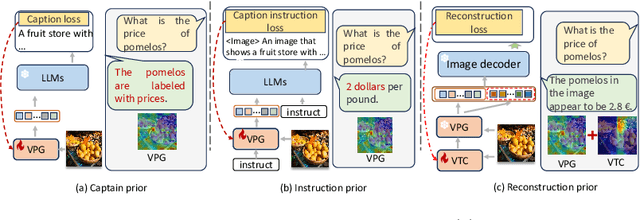
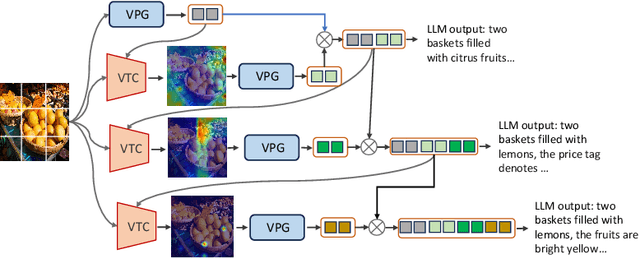
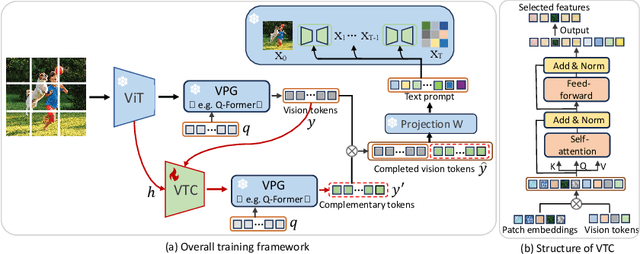
Abstract:As the open community of large language models (LLMs) matures, multimodal LLMs (MLLMs) have promised an elegant bridge between vision and language. However, current research is inherently constrained by challenges such as the need for high-quality instruction pairs and the loss of visual information in image-to-text training objectives. To this end, we propose a Visual Token Complement framework (VTC) that helps MLLMs regain the missing visual features and thus improve response accuracy. Specifically, our VTC integrates text-to-image generation as a guide to identifying the text-irrelevant features, and a visual selector is then developed to generate complementary visual tokens to enrich the original visual input. Moreover, an iterative strategy is further designed to extract more visual information by iteratively using the visual selector without any additional training. Notably, the training pipeline requires no additional image-text pairs, resulting in a desired instruction tuning-free property. Both qualitative and quantitative experiments demonstrate the superiority and efficiency of our VTC.
Classes Are Not Equal: An Empirical Study on Image Recognition Fairness
Mar 13, 2024Abstract:In this paper, we present an empirical study on image recognition fairness, i.e., extreme class accuracy disparity on balanced data like ImageNet. We experimentally demonstrate that classes are not equal and the fairness issue is prevalent for image classification models across various datasets, network architectures, and model capacities. Moreover, several intriguing properties of fairness are identified. First, the unfairness lies in problematic representation rather than classifier bias. Second, with the proposed concept of Model Prediction Bias, we investigate the origins of problematic representation during optimization. Our findings reveal that models tend to exhibit greater prediction biases for classes that are more challenging to recognize. It means that more other classes will be confused with harder classes. Then the False Positives (FPs) will dominate the learning in optimization, thus leading to their poor accuracy. Further, we conclude that data augmentation and representation learning algorithms improve overall performance by promoting fairness to some degree in image classification. The Code is available at https://github.com/dvlab-research/Parametric-Contrastive-Learning.
Doubly Abductive Counterfactual Inference for Text-based Image Editing
Mar 05, 2024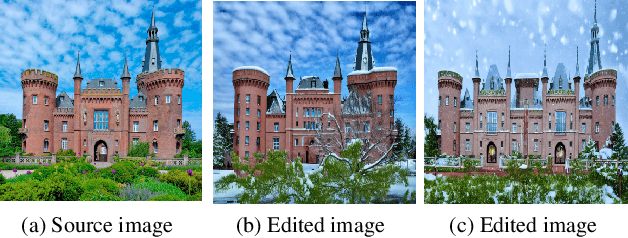

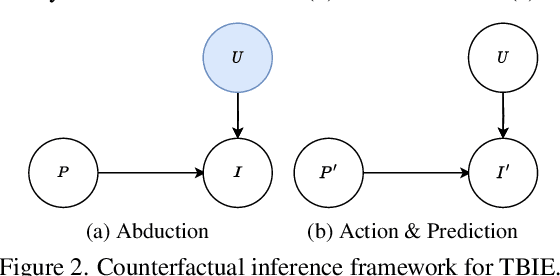

Abstract:We study text-based image editing (TBIE) of a single image by counterfactual inference because it is an elegant formulation to precisely address the requirement: the edited image should retain the fidelity of the original one. Through the lens of the formulation, we find that the crux of TBIE is that existing techniques hardly achieve a good trade-off between editability and fidelity, mainly due to the overfitting of the single-image fine-tuning. To this end, we propose a Doubly Abductive Counterfactual inference framework (DAC). We first parameterize an exogenous variable as a UNet LoRA, whose abduction can encode all the image details. Second, we abduct another exogenous variable parameterized by a text encoder LoRA, which recovers the lost editability caused by the overfitted first abduction. Thanks to the second abduction, which exclusively encodes the visual transition from post-edit to pre-edit, its inversion -- subtracting the LoRA -- effectively reverts pre-edit back to post-edit, thereby accomplishing the edit. Through extensive experiments, our DAC achieves a good trade-off between editability and fidelity. Thus, we can support a wide spectrum of user editing intents, including addition, removal, manipulation, replacement, style transfer, and facial change, which are extensively validated in both qualitative and quantitative evaluations. Codes are in https://github.com/xuesong39/DAC.
 Add to Chrome
Add to Chrome Add to Firefox
Add to Firefox Add to Edge
Add to Edge